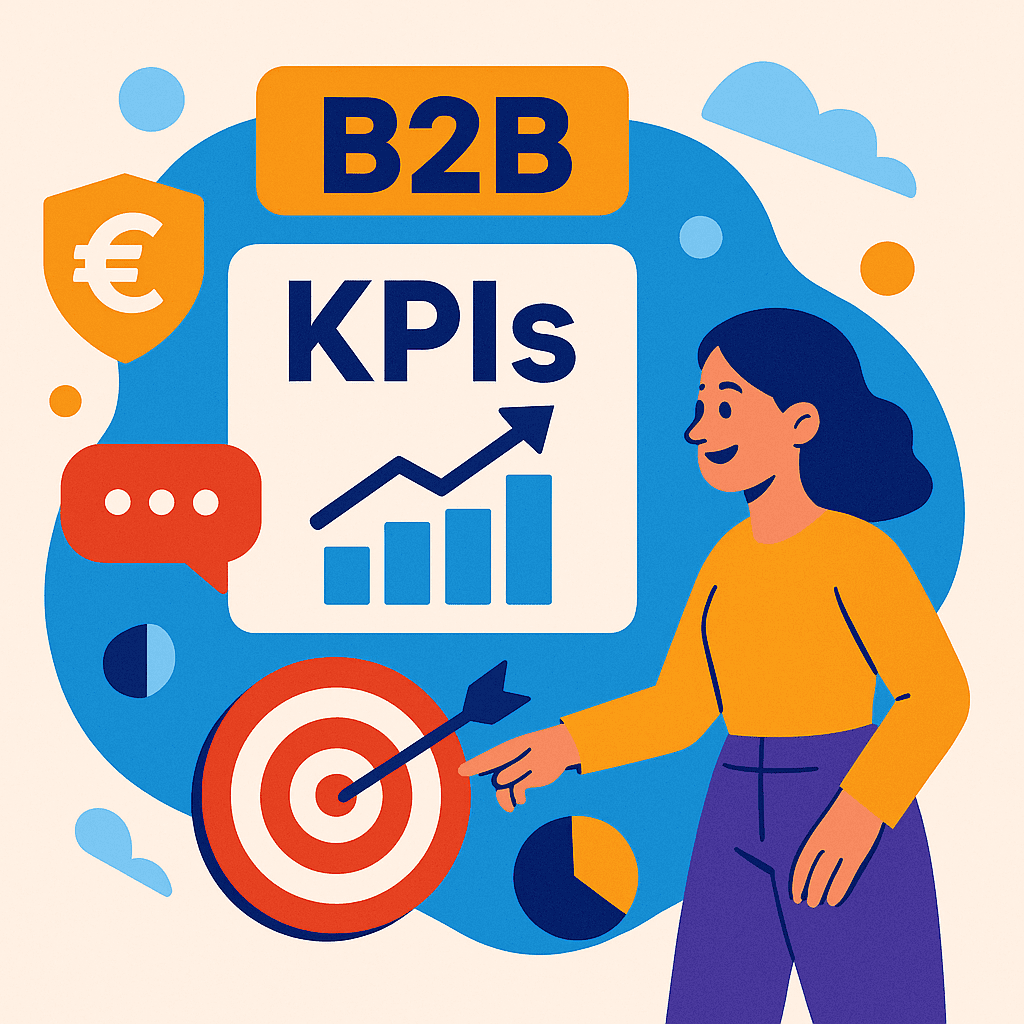We believe in measuring everything that can be measured in sales
How many times have you heard the phrase in a meeting: “What can’t be measured can’t be controlled”? This maxim, which has become a mantra in business, drives sales and marketing teams to multiply indicators. Endless Excel dashboards, 50 different metrics, 20-page weekly reports… Measurement has become an obsession.
B2B companies fall into this trap more easily than others. The long sales cycle, the multiple stakeholders in the purchasing process, the complexity of the products or services sold: everything seems to justify an exhaustive approach to measurement. Managers want to control, anticipate and optimize everything.
This race for metrics has intensified with the digitization of business processes. Modern CRM systems track every click, every email open, every website visit. Marketing automation tools generate detailed reports on prospect behavior. Email marketing platforms, such as Ediware, provide precise statistics, right down to the geolocation of openings.
Faced with this profusion of data, it’s tempting to want to measure everything. Number of leads generated, email open rate, number of followers on LinkedIn, time spent on the website, engagement score, bounce rate… The list goes on and on.
This approach is well-intentioned: making decisions based on facts rather than intuition. But it poses a fundamental problem that few companies anticipate.
The real problem: Too many metrics drown out the essential and paralyze action
Sales infobesity kills performance. When a team has to analyze 30 different indicators every week, it loses sight of the main objective: to sell more and better. Sales people spend more time filling in charts than prospecting. Managers get bogged down analyzing metrics that have no direct impact on sales.
This information overload generates several major dysfunctions. First, it dilutes attention. When everything seems important, nothing really is. Teams lose sight of the levers that have a direct impact on results. Secondly, it slows down decision-making. Faced with dozens of contradictory indicators, managers hesitate, procrastinate and ask for further analysis.
Above all, the multiplication of metrics encourages false optimizations. Teams focus on the indicators that are easiest to improve, not necessarily those with the greatest impact. Typically, in B2B email marketing, many companies obsess over open rates. They test dozens of email objects, fine-tune their sending schedules, segment their contact bases… All to gain a few points in open rate.
The problem? An excellent open rate doesn’t guarantee any return on investment. Better an email opened by 15% of recipients but generating 5 qualified appointments, than an email opened by 25% of contacts but producing no serious leads.
This drift particularly affects so-called “vanity” metrics. Number of followers on social networks, advertising impressions, website traffic… These indicators flatter the ego, but often have no connection with real business performance.
Take the example of an IT services company that recently contacted us. Their marketing manager was proud to present impressive statistics: 50,000 unique visitors per month to their website, 5,000 subscribers to their newsletter, 2,000 LinkedIn followers. Yet they were generating less than 10 qualified leads per month. Their problem? They were measuring everything but what mattered: the quality of their leads and their ability to convert them.
Vanity metrics create an illusion of performance. They give the impression that things are moving forward, that marketing efforts are bearing fruit. In reality, they often mask deeper problems: an inappropriate message, a poorly defined target, a faulty qualification process.
This confusion between activity and results paralyzes sales action. Teams work hard but make little progress. They optimize the wrong levers and neglect the real issues.
Actions: How to identify and track the KPIs that really count
Focus on a maximum of 5-7 KPIs per funnel stage
The golden rule of sales management? Less is more. A successful B2B company is satisfied with 5 to 7 key indicators, no more. These metrics must cover the entire sales funnel, from lead generation to customer loyalty.
Three fundamental indicators dominate all others: customer acquisition cost (CAC), customer lifetime value (LTV) and sales cycle time. These three metrics sum up the efficiency of your sales machine.
CAC measures how much each new customer costs you. It includes all marketing and sales investments: team salaries, tool costs, advertising budgets, prospecting costs. A CAC of 2,000 euros means that you need to invest this amount to acquire one customer.
LTV quantifies the total value a customer brings to your company over the entire duration of the business relationship. It takes into account average order value, purchase frequency and customer lifetime. A LTV of 15,000 euros means that a typical customer will bring you this amount before leaving for a competitor.
The LTV/CAC ratio is the key B2B indicator. It measures the profitability of your commercial investments. A minimum ratio of 3:1 is recommended, with 5:1 being the target. If your LTV is 15,000 euros and your CAC is 2,000 euros, you get a ratio of 7.5:1, a sign of excellent performance.
Sales cycle time completes this triptych. It measures the average time between the first contact with a prospect and the signing of a contract. In B2B, this metric varies enormously depending on the sector: from a few weeks for simple services to several months for complex solutions.
These three indicators are almost self-explanatory. They give a complete picture of the company’s commercial health. A rising CAC indicates a problem with targeting or sales efficiency. A declining LTV reveals loyalty-building difficulties or increased competitive pressure. A lengthening sales cycle often indicates an inappropriate message or a faulty qualification process.
To complete these three fundamental metrics, add a few indicators specific to your sales funnel. The lead-to-opportunity conversion rate measures the effectiveness of your qualification. The opportunity-to-customer conversion rate assesses the performance of your sales force. Average basket and purchase frequency refine LTV analysis.
Distinguish between activity metrics and results metrics
Confusion between activity and results plagues sales management. Activity metrics measure what teams do: number of calls made, emails sent, appointments made. Results metrics quantify the impact of these actions: revenues generated, customers acquired, contracts signed.
This distinction seems obvious, yet many companies ignore it. They set activity targets for their sales people: 50 calls a week, 200 emails a month, 10 appointments a quarter. This approach poses two major problems.
Firstly, it favors quantity over quality. A sales rep who calls 50 prospects a week without preparation will get mediocre results. Better 20 well-targeted and prepared calls than 50 “blind” calls.
Secondly, it takes the responsibility for results away from the teams. If the objective is to send 200 emails a month, it doesn’t matter whether they generate zero or ten appointments. The objective is reached as soon as the emails are sent.
Activity metrics are still useful for operational management. They can be used to identify bottlenecks and adjust resources. If a sales rep is only making 20 calls a week, while his colleagues are making 40, we need to understand why: lack of training, organizational problems, inadequate quality of the prospect file.
In B2B email marketing, this distinction takes on its full meaning. Activity metrics include number of emails sent, deliverability rate, open rate, click rate. Results metrics measure appointments generated, quotes requested, contracts signed thanks to campaigns.
An opening rate of 25% on an email campaign is a satisfactory metric of activity. But if this campaign generates zero sales appointments, the result is nil. Conversely, a 15% open rate that generates 10 qualified appointments is an excellent result.
At Ediware, we regularly observe this discrepancy. Customers contact us, concerned that their opening rates are “too low” compared to industry benchmarks. Digging deeper, we often discover that their campaigns are generating excellent ROI despite average activity metrics.
Why? They target their prospects better, personalize their messages more, and propose a more relevant offer. Their small but qualified audience reacts better than a large but poorly targeted base.
This logic applies to all prospecting channels. A salesperson who achieves a 50% telephone pick-up rate but doesn’t generate any appointments has a pitch or targeting problem. Another who picks up one call in ten but gets an appointment in every conversation has found the right approach.
Adapt indicators according to company maturity
Relevant KPIs evolve with a company’s maturity. A start-up in its seed phase does not follow the same metrics as an established SME or a large group. This adaptation reflects changing business priorities and challenges.
For a start-up looking for product-market fit, the main challenge is to validate the match between product and market. Priority metrics focus on the validation of needs and the receptiveness of prospects. Interest rates during demonstrations, product feedback, willingness to pay: these indicators take precedence over volumes or profitability.
At this stage, a high customer acquisition cost is not necessarily a problem. The main objective is to prove that customers are willing to pay for the product or service on offer. Lead volumes and conversion rates are secondary.
Scale-ups, in a phase of accelerated growth, are changing gear. They have validated their market and are now looking to industrialize their sales approach. Metrics focus on the efficiency and predictability of the sales funnel.
CAC becomes a central indicator, as the company needs to optimize its investments to accelerate growth. Sales cycle time is also gaining in importance: shortening lead times accelerates revenue generation and improves cash flow.
The measurement of sales productivity is becoming more refined. Revenues per sales rep, number of customers acquired per month, evolution of the average basket: these metrics can be used to calibrate teams and anticipate recruitment.
In email marketing, scale-ups pay more attention to automation and segmentation. They measure the effectiveness of their nurturing campaigns, lead scoring and conversion rates by segment. The challenge is to maximize the return on every euro invested in marketing.
Established companies focus on customer retention and development metrics. They have generally solved their acquisition problems and seek to optimize the value of their existing customer base.
LTV becomes the key indicator, accompanied by metrics such as churn rate, upsell rate and customer satisfaction. The aim is to maximize the profitability of each customer over the long term, rather than acquiring new accounts at all costs.
These companies are also developing more sophisticated approaches to measurement: multi-touch attribution, cohort analysis, churn prediction. They have the data volumes and resources required for these advanced analyses.
Automate collection to avoid bureaucracy
Measurement bureaucracy kills sales efficiency. When teams spend more time feeding dashboards than selling, the system malfunctions. Automating data collection solves this problem, while improving the reliability of information.
Modern CRM offers extensive automation possibilities. Integration with email marketing tools, synchronization with calendars, connection to prospecting platforms: these integrations eliminate double entry and reduce errors.
At Ediware, our API enables real-time synchronization with most CRMs on the market. Open, click and reaction statistics are automatically transferred to prospect files. Sales reps have instant access to their contacts’ behavior, with no manual handling required.
This automation transforms the daily life of sales teams. No more weekly Excel exports, no more manual status updates. Sales staff can concentrate on their core business: customer relations and sales.
The integration with Zapier, which we offer at Ediware, is a perfect illustration of this approach. Over 1,500 applications can connect to our platform, including CRM, productivity tools, billing solutions and e-commerce platforms. These connections create a unified ecosystem where information flows without human intervention.
Real-time dashboards are the ideal replacement for weekly reports. Managers can instantly visualize the evolution of key indicators, identify trends and detect problems before they escalate.
This real-time approach also transforms sales management. Instead of correcting deviations discovered at the end of the month after the fact, managers intervene immediately to correct any discrepancies. A salesperson in difficulty receives support before his or her results collapse.
Automation is not limited to data collection. It can also trigger corrective actions: automatic follow-up of inactive prospects, alerts in the event of a drop in performance, notification of urgent opportunities.
This logic of intelligent automation frees up time for high value-added activities: strategic analysis, sales coaching, development of new approaches. Teams spend less time on administrative tasks and more on optimizing performance.
The initial investment in automation is quickly recouped through productivity gains and improved data quality. Reliable, up-to-date information enables better business decisions.
Ultimately, measuring intelligently rather than exhaustively transforms sales performance. Companies that master this approach are one step ahead of their competitors. They act faster, adjust more precisely, invest more effectively.
The rule remains simple: a few well-chosen, automated indicators are better than dozens of metrics tracked manually. In B2B, the complexity of sales management demands simplicity of measurement.


